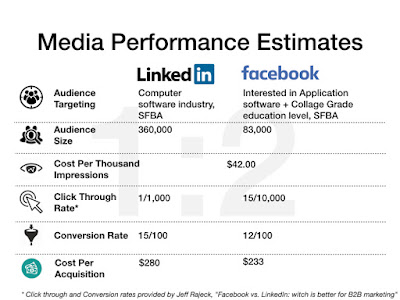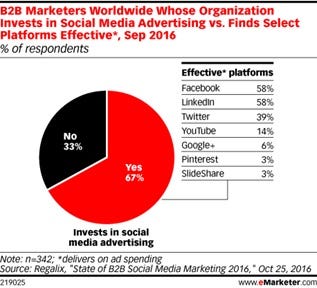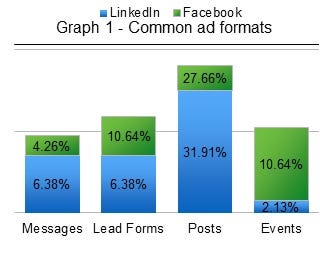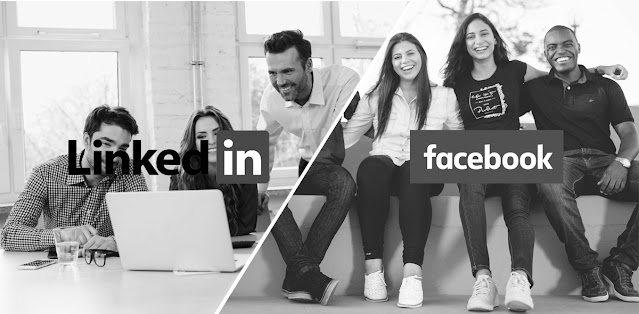LinkedIn vs. Facebook Advertising Effectiveness
The purpose of this paper is to determine the best social media network to advertise on for a B2B company in San Francisco Bay Area. Nowadays, essentially all business must engage with customers via channels like LinkedIn, Facebook and other social platforms because of the large percentage of the public using social media. It helps businesses to clearly build brand-awareness, interact with existing customers or prospects, and generate new leads for their sales teams. According to Justin Sachs (“The 7 Best Social Media Channels for Business Marketing”, August 26, 2016) LinkedIn and Facebook remain the most popular social media for business marketing and advertising on B2B markets. But which social network is the best to promote business-oriented products and services in Silicon Valley and San Francisco bay area? This was the question that I wanted to answer, so I began by conducting secondary research. I have checked several websites, blogs and business cases published on those networks’ website. It was important to evaluate each social media based on its ad audience size (the number of people who could possibly see an ad). Thus, my research shows that Facebook is the biggest social network on the web but LinkedIn gives more advantages to advertisers in San Francisco Bay Area, because of ad audience size it offers.
To approve my conclusion and hypothesis I developed an online survey and distributed it to marketing executives and companies owners who work in Northern California and Silicon Valley. The questionnaire consisted of 17 questions programmed into Qualtrics. The subsequent sample size was 34 respondents only, but the results are insightful. I have found out that LinkedIn was the most popular social media used by business to promote their services and products. Most respondents declared that LinkedIn has been found better social media to generate leads and to create brand-awareness, especially for small business in the consulting industry.
Based on these findings, I am able to prove that LinkedIn still remains the most important source of leads and a good option to promote business-oriented solutions in San Francisco Bay Area. Due to its audience size, it also the best choice for reaching a B2B audience of professionals in this area to create an awareness of a brand. Local businesses should use some advantages of this social media.
Introduction
Nowadays, social media is the most effective way of communicating with sales personas (prospects). It helps to acquire new business relationships and to educate prospects on agency’s services and offerings. But many marketing specialists cannot decide which social network to focus on to promote their business-oriented services and goods. In most cases marketing managers prefer to use LinkedIn rather than Facebook to approach prospective clients and generate leads. The main purpose of this research is to find out the most effective way to advertise on social media for business to business companies in San Francisco Bay Area. The results of this research will allow any B2B company who works in the software industry in Silicon Valley to effectively leverage its marketing budget and develop an effective approach to reach potential clients, by focusing on the most effective social media.
I still strongly believe that LinkedIn is the best way to promote business-oriented solutions as it has developed a reputation for being the top B2B social media platform for these companies. I have focused my research to prove my thoughts. Content Marketing Institute (“What Effective B2B Content Marketing Looks Like”, September 30, 2015) found that 63% of marketers rated LinkedIn as the most effective B2B social media platform. According to Pew Research Center (2015), 72% of adult internet users use Facebook and only 25% of adult internet users use LinkedIn. But on the other hand, LinkedIn is the only major social media platform for which usage rates are higher among 30 — to 49-year-olds than among 18 — to 29-year-olds.
Over the past five years, advertising budgets allocated to internet media have grown spectacularly. Based on Measuring the effectiveness of online advertising report by PwC (2010, page 5), in 2010, the internet represented 16% of total advertising expenditure worldwide and this figure reached 21% in the next four years. This growth is significantly fueled by search and “performance” tools (affiliate marketing, email, comparison websites, etc.), although display advertising continues to represent a large portion of online budgets (49% in 2010 and 45% in 2014). In December 2017, CNBS declared that half of all global advertising dollars will be spent online by 2020, matching the worldwide combined “offline” ad spend, such as TV, print ads and billboard posters, according to forecasts. Digital media will take 44%, or $237 billion, of all ad money spent globally in 2018, with that figure reaching 50%, or $291 billion, by 2020.
Digital marketing turns traditional marketing models on their heads. Instead of telling the customer what to think, businesses find out what they already think and go from there. Instead of front-loading resources, companies continually adjust their approach based on real interactions with real customers every day.
The major advantage of digital marketing for a B2B company is an ability to track the performance and effective lead generation mechanism. Advertisers realize that measuring performance is an important issue, but for the most part they face difficulties in implementing appropriate methods and indicators. This is due to a lack of resources and tools and the need for organizations to strengthen their expertise.
More than two-thirds of business-to-business (B2B) marketers worldwide devote dollars to social media advertising, according to September research published by eMarketer in 2016. And among those who do, platforms like Facebook and LinkedIn appear to deliver the best ROI.
Methodology
For my research I used both secondary and primary data. The secondary research was conducted on the Internet, books and business magazines, but to gather primary data I used self-administrated internet-based questionnaire survey. The sample size for the survey was 34 respondents who worked at B2B companies in various industries in Northern California, the United States. The margin of error with this sample was +/- 16.8% with a 95% confidence interval.
Findings
To find main information regarding the topic of the research and identified the most accurate secondary research sources I have looked through Facebook and LinkedIn websites first and read several cases about how B2B companies advertised on those social media.
Facebook demonstrates the effectiveness of advertising on this network in Cisco WebEx Case. The company advertised to attract more potential customers, get more demo download requests. In October 2015 Cisco WebEx found Facebook lead ads to be the most efficient way of generating leads and conversions across all platforms. At the end of the campaign, the company received 84% increase in return on ad spend over other social platforms, 3X conversion rate and cost per click 75% lower than links ads.
LinkedIn has much more cases then its competitor. The best example for my research was Chase Case. In 2015 that bank raised awareness of its Mission Main Street Grants program to small business owners by leveraging a multi-product strategy of different advertising tools used on LinkedIn and an email that reached nearly one million small business owners within LinkedIn’s network. At the end of the year, they saw a record of 30,000 registrants for the Mission Main Street Grants program (it was considered as an 18% increase from 2014). Highly targeted campaigns with relevant, insightful content will remain an integral tool for Chase in the years to come. Main advertising results were: 1.7 million individuals voted 70% lower average cost-per-visitor than industry benchmarks, 200% greater than industry benchmarks for Sponsored Content click through and engagement rates.
To gather more information about both social media as B2B products promotion channels and to find out what experts think about both networks I have made a quick search on Econsultancy and Emarketer websites.
According to Jeff Rajeck (eConsultant, 2014) to find out the best social media for a B2B campaign it requires to evaluate each social media based on its ad audience size first. That is the number of people who could possibly see an ad on a platform of choice. Once the audience size is known, company can estimate its campaign performance and select a better platform for its B2B campaign.
To demonstrate the difference in ad audience between Facebook and LinkedIn I have checked if the number of people who worked in IT/Internet/Software in San Francisco Bay Area on LinkedIn and on Facebook respectively. After the audience size has been determined for each network, the network still needs to gage its effectiveness, using average estimation processes as recommended by each platform.
 |
| LinkedIn and Facebook Campaigns Performance Estimates |
Facebook and LinkedIn have different missions. They are in possess of different data and also use different parameters to set up an ad campaign. To predict the performance of an advertising campaign targeted to software developers and users on Facebook, I used ‘interest’ parameter set to ‘Application software’, education level equaled to ‘College Grad’ and the location was limited to San Francisco Bay Area. To set up the similar advertising campaign on LinkedIn I used ‘Computer software’ as an industry parameter and the location settings set to Bay Area.
[*] Click through and Conversion rates provided by Jeff Rajeck, “Facebook vs. LinkedIn: witch is better for B2B marketing”
 |
| Social Media Platforms Effectiveness by eMarketer (2016) |
In this example, Facebook is the better place to spend time and marketing dollars in terms of lead generation but platform audiences vary widely depending on what location and industry you are marketing into. In my example, the performance of Facebook is limited due to its audience size. 15 leads are not enough even for small business. LinkedIn’s ad audience is multiple times bigger than Facebook’s audience size.
For the whole San Francisco Bay Area the ad audience size is 460,000 people on Facebook and 4,800,000 people on LinkedIn respectively (data provided by Facebook Audience Insights and LinkedIn Campaign Manager, February 2018).
Based on eMarketer research (2016) Facebook’s effectiveness comes out on top for most social media marketers worldwide, not just B2B practitioners. In March 2016, research from Social Fresh, Firebrand Group and Simply Measured revealed that 95.8% of these marketers said the platform produces the best ROI.
I have also checked other B2B oriented websites and come up with following important outlines:
| Facebook has 1.13 billion daily active users (Statista, 2016) | LinkedIn has 450 million memebers, but only 25% actively visit the professional social network each month. (VentureBeat, 2016) |
| In the past two years, content consumption on Facebook has increase 57%. (HubSpot, 2016) | In the past two yeaars, content consumption on Facebook has increase 21%. |
| 74% of people say they use Facebook for professional purposes. (HubSpot, 2017) | 25% of adult internet users use LinkedIn. (Pew Research Center, 2015) |
| Facebook continues to have the most engaged users - 70% log on daily, including 43% who do so several times a day. (Pew Research Center, 2015) | 32% of employed adults are LinkedIn users, compared with 14% of online adults who are not employed. (Pew Research Center, 2015) |
Since I needed to test my primordial hypothesis I decided to generate a survey to bet input from the people who work in business-oriented industries in Northern California. I have limited the list of respondents to six major industries (mostly software and consulting, including advertising / digital marketing services) and the area to San Francisco Bay Area. The survey contained 17 questions programmed into Qualtrics and had a goal to reveal the best practice of using social media, determine satisfaction rate and find out the most effective social media to advertise on.
 |
| Common ad formats on LinkedIn and Facebook |
34 of 46 respondents have confirmed that they work or worked in a company who dial with other businesses, and the biggest group (up to 73%) is represented by 1–10 employees companies, and more than 68% of them operates in consulting and services industry. According to the data provided by the survey, 69% of respondents use social media to promote their business services on regular bases and over the last six months, LinkedIn was used 10% often than Facebook. In 37% of cases, companies advertise on those social media to create their brand-awareness and in 31% of cases — to generate leads and use many different formats. 70% of respondents found LinkedIn the best in term of the biggest representation of their target audience and Facebook the best in terms of building and setting up a campaign. 57% reported that LinkedIn has the best conversion rate. They have told me that the audience of this network were more engaged in business products of financial and real estate industries. Thus it is common practice for other industries, especially when it is needed to reach people with specific job roles and in specific departments.
I have reordered from the survey that 38% of companies are going to use Facebook rather than LinkedIn to advertise on and even to use as a platform to sell some of their services online. On the other hand, 47% respondents declared that LinkedIn is a better choice to create an awareness and generate leads for their sales team, and they are likely to use out again.
 |
| Social media performance vs. possibility of repeated usage (% of respondents, usage likeliness level) |
Conclusions and Recommendations
Facebook is the biggest social network on the web, both in terms of name recognition and a total number of users. Because of nearly 2 billion active users, Facebook is a great medium for connecting people from all over the world with businesses. Facebook has a wealth of options for any type of organization, and it’s a great starting point for your business, regardless of any industry. On the other hand, if a company’s business is limited to San Francisco Bay Area LinkedIn gives more advantages to advertisers, it offers bigger audience which is also could be easily segmented by many different parameters Facebook has not got.
According to Forbes magazine (Josh Bersin, May 21, 2012), LinkedIn’s strength in this market is its “#1 position” as the professional network in the world and its strong data analysis skills and capabilities. As far as reaching out to hourly workers, blue collar workers, and non-professionals, today it’s not clear that LinkedIn can (or wants to) extend itself in these directions. The entire website is designed as an “information reach” system, not a “photo and personal sharing” system liked Facebook and other networks.
Based on my secondary research, I have found out that in terms of awareness LinkedIn beats Facebook, at least in my geographic location. Unfortunately some business to business companies still prefer to advertise on Facebook rather than on LinkedIn due to convenience. Primary research’s data demonstrated that the majority of respondents consider Facebook to offer very powerful advertising campaign builder. Facebook can be used for reaching both a business and consumer audience and offers several ways to target, such as interests which include business interests and job titles.
On the other hand, LinkedIn offers a variety of ways to target audience based on job function, seniority, industry and more, this is something Facebook cannot provide yet.
Thus as a digital marketing specialist, I would prefer to test advertising performance of each social media for the specific market audience first by using small market segment and a limited budget to find out the cost per conversion and the conversion rate in each case.
I recommend implementing that approach for any social media. In case if I need to choose between LinkedIn and Facebook to spend my media budget with to generate new leads, I would mostly go with LinkedIn, especially in the software industry. Data on an audience to leads (prospects) conversion rate speaks for itself. And this network is designed to serve that purpose. Last but not least, my research has presented that because of the audience size of LinkedIn applicable to San Francisco bay area, network remains the best option for wide reach of a B2B audience of professionals if the goal is to create an awareness of a brand. Local Northern California businesses should use such advantages of this social media.
References
Articles
- PwC for IAB France and the SRI. “Measuring the effectiveness of online advertising”. PwC. 2010;
- Joe Pulizzi. “What Effective B2B Content Marketing Looks Like”. Content Marketing Institute. September 30, 2015;
- Janet Driscoll Miller. “Advertising LinkedIn vs. Facebook, which should you choose?”. Marketing Mojo. 2014;
- Josh Bersin. “Facebook vs. LinkedIn — What’s the Difference?”.Forbes. May 21, 2012.
Books
- Ian Dodson. The Art of Digital Marketing: The Definitive Guide to Creating Strategic, Targeted, and Measurable Online Campaigns. Hardcover. Wiley. April 18, 2016;
- PricewaterhouseCoopers LLP. Global Entertainment and Media Outlook: 2010–2014. PricewaterhouseCoopers LLP. 2010.
Web site page/article
- Justin Sachs. “The 7 Best Social Media Channels for Business Marketing”. Huffingtonpost, Internet: huffingtonpost.com/young-entrepreneur-council/the-10-best-social-media_b_11654820.html, August 26, 2016;
- Hubspot. “The Ultimate List of Marketing Statistics”. Hubspot. Internet: hubspot.com/marketing-statistics, February 2018;
- Lucy Handley. “Half of all advertising dollars will be spent online by 2020, equaling all combined ‘offline’ ad spend globally”. CNBS. Internet: cnbc.com/2017/12/04/global-advertising-spend-2020-online-and-offline-ad-spend-to-be-equal.html. December 4, 2017
- eMarketer. “Facebook, LinkedIn Ads Deliver Best Value to B2B Social Marketers”. eMarketer. Internet: emarketer.com/Article/Facebook-LinkedIn-Ads-Deliver-Best-Value-B2B-Social-Marketers/1014694, November 8, 2016;
- Facebook Business. “Cisco WebEx”. Facebook. Internet: facebook.com/business/success/cisco-webex. February 10, 2018;
- LinkedIn. “WORKING TOGETHER TO INSPIRE SMALL BUSINESS GROWTH”. LinkedIn. Internet: business.linkedin.com/content/dam/me/business/en-us/marketing-solutions/case-studies/pdfs/chase-for-business-banking-mission.pdf. February 10, 2018;
- Jeff Rajeck. “Facebook vs. LinkedIn: which is better for B2B marketing?”. eConsultant. Internet: econsultancy.com/blog/65145-facebook-vs-linkedin-which-is-better-for-b2b-marketing/. July 9, 2014.





